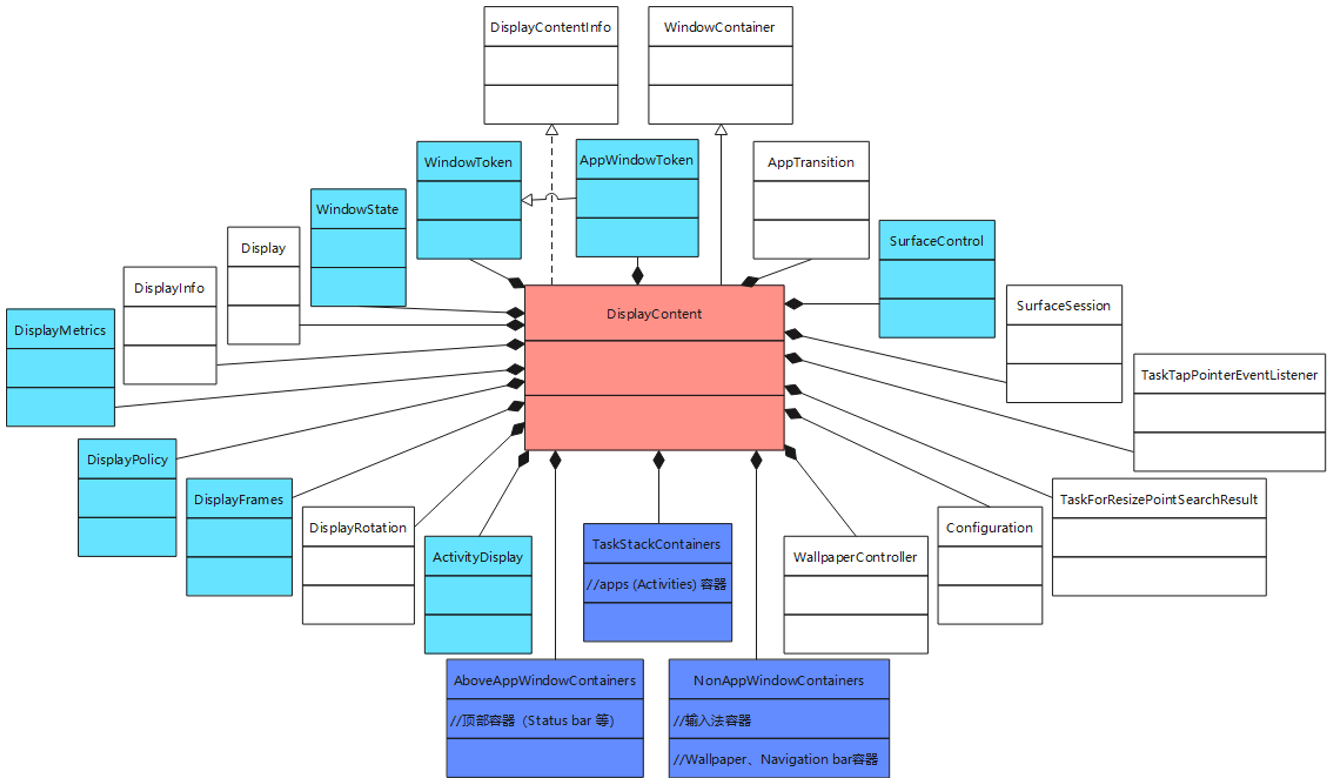1 前言
DisplayContent 用于管理屏幕,一块屏幕对应一个 DisplayContent 对象,虽然手机只有一个显示屏,但是可以创建多个 DisplayContent 对象,如投屏时,可以创建一个虚拟的 DisplayContent。
关于其父类及祖父类的介绍,见 → WindowContainer简介、ConfigurationContainer简介,其父容器的介绍见 → RootWindowContainer简介。

DisplayContent 的子容器类型为 DisplayChildWindowContainer,其子类有:TaskStackContainers、AboveAppWindowContainers、NonAppWindowContainers。实现的对象有:
- mTaskStackContainers:apps (Activities) 容器
- mAboveAppWindowsContainers:顶部容器(如:Status bar 等)
- mBelowAppWindowsContainers:NonAppWindowContainers 类型,底部容器(如:Wallpaper、Navigation bar 等)
- mImeWindowsContainers:NonAppWindowContainers 类型,输入法容器
2 源码
源码地址→/frameworks/base/services/core/java/com/android/server/wm/DisplayContent.java
(1)类定义
//DisplayChildWindowContainer 为子节点类型
class DisplayContent extends WindowContainer<DisplayContent.DisplayChildWindowContainer> implements WindowManagerPolicy.DisplayContentInfo
(2)主要属性
private final int mDisplayId
boolean isDefaultDisplay
ActivityDisplay mAcitvityDisplay
//apps (Activities) 容器
private final TaskStackContainers mTaskStackContainers = new TaskStackContainers(mWmService)
//顶部容器(如:Status bar 等)
private final AboveAppWindowContainers mAboveAppWindowsContainers = new AboveAppWindowContainers("mAboveAppWindowsContainers", mWmService)
//底部容器(如:Wallpaper、Navigation bar 等)
private final NonAppWindowContainers mBelowAppWindowsContainers = new NonAppWindowContainers("mBelowAppWindowsContainers", mWmService)
//输入法容器
private final NonAppWindowContainers mImeWindowsContainers = new NonAppWindowContainers("mImeWindowsContainers", mWmService)
final ArraySet<AppWindowToken> mOpeningApps = new ArraySet<>()
final ArraySet<AppWindowToken> mClosingApps = new ArraySet<>()
final ArraySet<AppWindowToken> mChangingApps = new ArraySet<>()
private final HashMap<IBinder, WindowToken> mTokenMap = new HashMap()
int mInitialDisplayWidth = 0
int mInitialDisplayHeight = 0
int mInitialDisplayDensity = 0
int mBaseDisplayWidth = 0
int mBaseDisplayHeight = 0
int mBaseDisplayDensity = 0
private final DisplayInfo mDisplayInfo = new DisplayInfo()
private final Display mDisplay
private final DisplayMetrics mDisplayMetrics = new DisplayMetrics()
private final DisplayPolicy mDisplayPolicy
private DisplayRotation mDisplayRotation
DisplayFrames mDisplayFrames
final DisplayMetrics mRealDisplayMetrics = new DisplayMetrics();
private final DisplayMetrics mTmpDisplayMetrics = new DisplayMetrics();
private final DisplayMetrics mCompatDisplayMetrics = new DisplayMetrics()
float mCompatibleScreenScale
private int mRotation = 0
private int mLastOrientation = SCREEN_ORIENTATION_UNSPECIFIED;
private int mLastWindowForcedOrientation = SCREEN_ORIENTATION_UNSPECIFIED;
private int mLastKeyguardForcedOrientation = SCREEN_ORIENTATION_UNSPECIFIED;
private Rect mBaseDisplayRect = new Rect()
final ArrayList<WindowToken> mExitingTokens = new ArrayList<>()
final TaskTapPointerEventListener mTapDetector
final DockedStackDividerController mDividerControllerLocked
final PinnedStackController mPinnedStackControllerLocked
WallpaperController mWallpaperController
private final SurfaceSession mSession = new SurfaceSession()
WindowState mCurrentFocus = null;
WindowState mLastFocus = null
ArrayList<WindowState> mLosingFocus = new ArrayList<>()
AppWindowToken mFocusedApp = null
private SurfaceControl mOverlayLayer;
private SurfaceControl mWindowingLayer
private InputMonitor mInputMonitor
private boolean mLastHasContent
WindowState mInputMethodWindow
WindowState mInputMethodTarget
boolean mInputMethodTargetWaitingAnim
private final PointerEventDispatcher mPointerEventDispatcher
private final InsetsStateController mInsetsStateController
private WindowState mParentWindow
private Point mLocationInParentWindow = new Point()
private SurfaceControl mParentSurfaceControl
private InputWindowHandle mPortalWindowHandle
private final float mWindowCornerRadius
(3)构造方法
DisplayContent(Display display, WindowManagerService service, ActivityDisplay activityDisplay) {
//Display相关
mDisplay = display
mDisplayId = display.getDisplayId()
display.getDisplayInfo(mDisplayInfo)
display.getMetrics(mDisplayMetrics)
//壁纸
mWallpaperController = new WallpaperController(mWmService, this)
//输入相关(点击、触摸等)
final InputChannel inputChannel = mWmService.mInputManager.monitorInput("PointerEventDispatcher" + mDisplayId, mDisplayId)
mInputMonitor = new InputMonitor(service, mDisplayId)
mPointerEventDispatcher = new PointerEventDispatcher(inputChannel)
mTapDetector = new TaskTapPointerEventListener(mWmService, this);
registerPointerEventListener(mTapDetector);
registerPointerEventListener(mWmService.mMousePositionTracker)
//策略
mDisplayPolicy = new DisplayPolicy(service, this)
mDisplayRotation = new DisplayRotation(service, this)
//添加子容器
super.addChild(mBelowAppWindowsContainers, null)
super.addChild(mTaskStackContainers, null)
super.addChild(mAboveAppWindowsContainers, null)
super.addChild(mImeWindowsContainers, null)
//将该对象添加到根容器中
mWmService.mRoot.addChild(this, null)
}
(4)获取/注入属性
//mDisplayId
int getDisplayId()
//mWindowCornerRadius
float getWindowCornerRadius()
//mTokenMap.get(binder)
WindowToken getWindowToken(IBinder binder)
//mDisplay
public Display getDisplay()
//mDisplayInfo
DisplayInfo getDisplayInfo()
//mDisplayMetrics
DisplayMetrics getDisplayMetrics()
//mDisplayPolicy
DisplayPolicy getDisplayPolicy()
//mInsetsStateController
InsetsStateController getInsetsStateController()
//mDisplayRotation
public DisplayRotation getDisplayRotation()
//mDisplayRotation = displayRotation
void setDisplayRotation(DisplayRotation displayRotation)
//mRotation
int getRotation()
//mRotation = newRotation
//mDisplayRotation.setRotation(newRotation)
void setRotation(int newRotation)
//mLastOrientation
int getLastOrientation()
//mLastWindowForcedOrientation
int getLastWindowForcedOrientation()
(5)消费者
//w 为 WindowState 类型
private final Consumer<WindowState> mUpdateWindowsForAnimator = w -> {
//mWmService.mWindowPlacerLocked.debugLayoutRepeats("updateWindowsAndWallpaperLocked 5", pendingLayoutChanges)
}
private final Consumer<WindowState> mUpdateWallpaperForAnimator = w -> {
//final AnimationAdapter anim = w.mAppToken != null ? w.mAppToken.getAnimation() : w.getAnimation()
//final TaskStack stack = w.getStack()
//stack.setAnimationBackground(winAnimator, color)
}
private final Consumer<WindowState> mScheduleToastTimeout = w -> {
//final Handler handler = mWmService.mH
//handler.sendMessageDelayed(handler.obtainMessage(WINDOW_HIDE_TIMEOUT, w), w.mAttrs.hideTimeoutMilliseconds)
}
private final Consumer<WindowState> mPerformLayout = w -> {
//w.resetContentChanged()
//w.prelayout()
//mDisplayPolicy.layoutWindowLw(w, null, mDisplayFrames)
//w.updateLastInsetValues()
//w.mAppToken.layoutLetterbox(w)
}
private final Consumer<WindowState> mPerformLayoutAttached = w -> {
//w.resetContentChanged()
//w.prelayout()
//mDisplayPolicy.layoutWindowLw(w, w.getParentWindow(), mDisplayFrames)
}
private final Consumer<WindowState> mApplyPostLayoutPolicy = w -> {
//mDisplayPolicy.applyPostLayoutPolicyLw(w, w.mAttrs, w.getParentWindow(), mInputMethodTarget)
}
private final Consumer<WindowState> mApplySurfaceChangesTransaction = w -> {
//mWallpaperController.updateWallpaperVisibility()
//w.handleWindowMovedIfNeeded()
//w.resetContentChanged()
//mWmService.mH.obtainMessage(REPORT_LOSING_FOCUS, this).sendToTarget()
//w.updateResizingWindowIfNeeded()
}
其中,Consumer 类如下:
public interface Consumer<T> {
void accept(T t);
default Consumer<T> andThen(Consumer<? super T> after) {
Objects.requireNonNull(after);
return (T t) -> { accept(t); after.accept(t); };
}
}
(6)谓词
//w 为 WindowState 类型
private final Predicate<WindowState> mComputeImeTargetPredicate = w -> {
//return w.canBeImeTarget()
}
其中,Predicate 接口如下:
public interface Predicate<T> {
boolean test(T t);
//与运算:return (t) -> test(t) && other.test(t)
default Predicate<T> and(Predicate<? super T> other)
//非运算:return (t) -> !test(t)
default Predicate<T> negate()
//或运算:return (t) -> test(t) || other.test(t)
default Predicate<T> or(Predicate<? super T> other)
//判等运算:return object -> targetRef.equals(object)
static <T> Predicate<T> isEqual(Object targetRef)
}
(7)函数
private final ToBooleanFunction<WindowState> mFindFocusedWindow = w -> {
//mTmpWindow = w
}
其中,ToBooleanFunction 接口如下:
public interface ToBooleanFunction<T> {
boolean apply(T value);
}
(8)Token 相关
//getWindowToken(binder).asAppWindowToken()
AppWindowToken getAppWindowToken(IBinder binder)
//final WindowToken token = removeWindowToken(binder)
//final AppWindowToken appToken = token.asAppWindowToken()
//appToken.onRemovedFromDisplay()
void removeAppToken(IBinder binder)
//final WindowToken token = mTokenMap.remove(binder)
WindowToken removeWindowToken(IBinder binder)
//addWindowToken(token.token, token)
void reParentWindowToken(WindowToken token)
(9)Orientation 相关
//mDisplayRotation.respectAppRequestedOrientation()
boolean handlesOrientationChangeFromDescendant()
//updateOrientationFromAppTokens(false)
boolean updateOrientationFromAppTokens()
//updateOrientationFromAppTokens(forceUpdate)
//computeScreenConfiguration(config)
Configuration updateOrientationFromAppTokens(Configuration currentConfig, IBinder freezeDisplayToken, boolean forceUpdate)
(10)Rotation 相关
//updateRotationAndSendNewConfigIfNeeded()
void resumeRotationLocked()
//final int rotation = mDisplayRotation.rotationForOrientation(lastOrientation, oldRotation)
boolean rotationNeedsUpdate()
//sendNewConfiguration()
boolean updateRotationAndSendNewConfigIfNeeded()
//updateRotationUnchecked(false)
boolean updateRotationUnchecked()
//final int rotation = mDisplayRotation.rotationForOrientation(lastOrientation, oldRotation)
//mWmService.mH.sendNewMessageDelayed(WindowManagerService.H.WINDOW_FREEZE_TIMEOUT, this, WINDOW_FREEZE_TIMEOUT_DURATION)
//setLayoutNeeded()
boolean updateRotationUnchecked(boolean forceUpdate)
//mDisplayRotation.setRotation(rotation)
//updateDisplayAndOrientation(getConfiguration().uiMode, null)
void applyRotationLocked(final int oldRotation, final int rotation)
(11)其他方法
//mWmService.mDisplayReady && mDisplayReady
boolean isReady()
//mWmService.mH.obtainMessage(SEND_NEW_CONFIGURATION, this).sendToTarget()
void sendNewConfiguration()
//mDisplayPolicy.updateConfigurationAndScreenSizeDependentBehaviors();
//mDisplayRotation.configure(width, height, shortSizeDp, longSizeDp);
//mDisplayFrames.onDisplayInfoUpdated(mDisplayInfo, calculateDisplayCutoutForRotation(mDisplayInfo.rotation))
void configureDisplayPolicy()
//mWmService.mPolicy.adjustConfigurationLw(config, keyboardPresence, navigationPresence)
void computeScreenConfiguration(Configuration config)
声明:本文转自【framework】DisplayContent简介
标签:int,简介,DisplayContent,private,framework,boolean,mWmService,new,final From: https://www.cnblogs.com/zhyan8/p/17233666.html